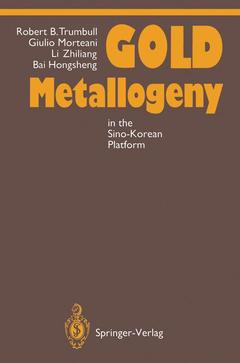Description
Gold Metallogeny, Softcover reprint of the original 1st ed. 1992
in the Sino-Korean Platform
Authors: Trumbull Robert B., Morteani Giulio, Li Zhiliang, Bai Hongsheng
Language: English
Subject for Gold Metallogeny:
Keywords
Archean; Archäikum; China/Hebei; Gold; Hebei; Lagerstätten; geochemistry; ore deposits; petrography; mineral resources
Approximative price 52.74 €
In Print (Delivery period: 15 days).
Add to cart
Publication date: 12-2011
202 p. · 15.5x23.5 cm · Paperback
202 p. · 15.5x23.5 cm · Paperback
Description
/li>Contents
/li>
Examples from Hebei Province, NE China
1 Introduction.- 1.1 Regional Tectonic Division of China.- 1.2 The Gold Provinces of Northeastern China.- 1.3 Gold in Eastern Hebei Province.- 2 Geologic Framework of the Sino-Korean Platform.- 2.1 Major Orogenic Events.- 2.1.1 Archean: Qianxi Orogeny.- 2.1.2 Early to Middle Proterozoic: Fuping and Wutai Orogenies.- 2.1.3 Middle to Late Proterozoic: Zhongtiao and Yangtze Orogenies.- 2.1.4 Paleozoic: Caledonian and Variscan Orogenies.- 2.1.5 Mesozoic: Indosinian and Yanshanian Orogenies.- 2.1.6 Cenozoic: Pacific Margin and the Himalayan Orogeny.- 2.2 The Precambrian Basement.- 2.2.1 Archean Rocks.- 2.2.2 Proterozoic Rocks.- 2.3 Structural Geology.- 2.3.1 Precambrian Structures.- 2.3.2 Regional Faults and Lineaments.- 2.3.3 Structural Features of the Major Fault Zones.- 2.4 Yanshanian Granites.- 2.4.1 Regional Characteristics and Plate Tectonic Setting.- 2.4.2 Yanshanian Magmatism in Eastern China.- 2.4.3 Yanshanian Granites in Eastern Hebei Province.- 3 Description of Selected Gold Deposits.- 3.1 Niuxinshan District.- 3.1.1 Host Rock Lithologies.- 3.1.2 Host Rock Structures.- 3.1.3 Gold Mineralization.- 3.1.4 Wall Rock Alteration.- 3.1.5 Age of Mineralization.- 3.1.6 Fluid Inclusions.- 3.1.7 Stable Isotopic Data.- 3.2 Sanjia District.- 3.2.1 Host Rock Lithology.- 3.2.2 Host Rock Structures.- 3.2.3 Gold Mineralization.- 3.2.4 Wall Rock Alteration.- 3.2.5 Age of Mineralization.- 3.2.6 Fluid Inclusions.- 3.2.7 Stable Isotopic Data.- 3.3 Yuerya District.- 3.3.1 Host Rock Lithology.- 3.3.2 Host Rock Structures.- 3.3.3 Gold Mineralization.- 3.3.4 Wall Rock Alteration.- 3.3.5 Age of Mineralization.- 3.3.6 Fluid Inclusions.- 3.4 Jinchangyu District.- 3.4.1 Host Rock Lithology.- 3.4.2 Host Rock Structures.- 3.4.3 Gold Mineralization.- 3.4.4 Wall Rock Alteration.- 3.4.5 Age of Mineralization.- 3.4.6 Fluid Inclusions.- 3.5 Banbishan District.- 3.5.1 Host Rock Lithology.- 3.5.2 Host Rock Structures.- 3.5.3 Gold Mineralization.- 3.5.4 Wall Rock Alteration.- 3.5.5 Age of Mineralization.- 4 Aspects of Metallogenesis.- 4.1 The Age of Mineralization.- 4.1.1 Field Relations.- 4.1.2 Isotopic Age Dates.- 4.2 The Source of Gold.- 4.2.1 Gold in the Qianxi Group: The “Source Bed” Concept.- 4.2.2 Gold in Yanshanian Granites.- 4.2.3 Isotopic Contraints.- 4.2.4 The Mantle Connection.- 4.2.5 Conclusions.- 4.3 The Role of Iron-Rich Host Rocks.- 4.3.1 Banded Iron Formations in Northeastern China.- 4.3.2 Petrography and Composition of Magnetite Quartzites.- 4.3.3 Sulfidization and Gold Mineralization.- 4.3.4 Conclusions.- 4.4 The Role of Yanshanian Granites.- 4.4.1 Granite Compositions.- 4.4.2 Heat Production.- 4.4.3 Conclusions.- 4.5 Structural Controls.- 4.5.1 Regional Structures.- 4.5.2 Local Structures.- 4.5.3 Regional Tectonic Interpretation.- 4.6 Fluid Composition and P-T Conditions of Mineralization.- 4.6.1 Evidence from Fluid Inclusions.- 4.6.2 Stable Isotopic Data.- 4.6.3 Gold Transport and Precipitation.- 5 Towards a Metallogenetic Model.- 5.1 Previous Models.- 5.2 The Preferred Model for Eastern Hebei Province.- 5.3 Open Questions.- 6 Comparison with Other Archean-Hosted Gold Provinces.- Appendix 1.- Appendix 2.- References.
© 2024 LAVOISIER S.A.S.

